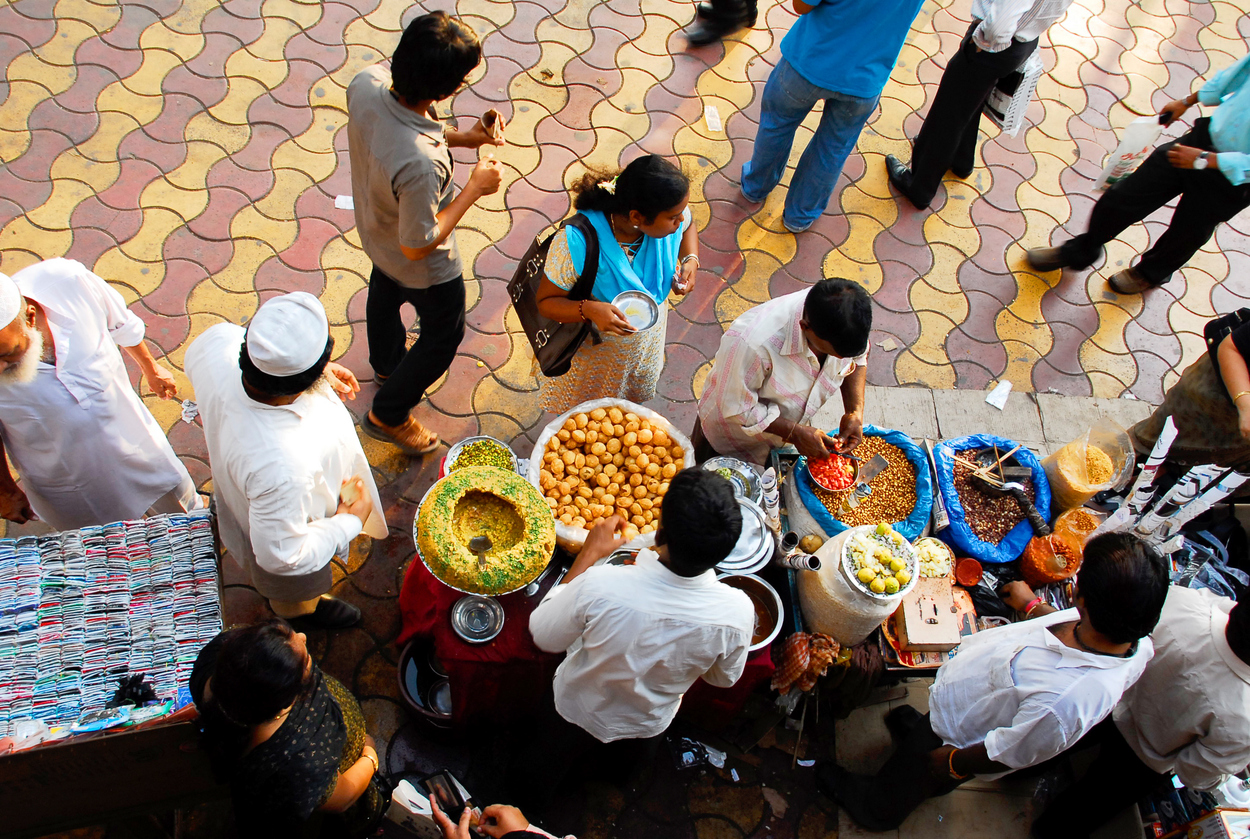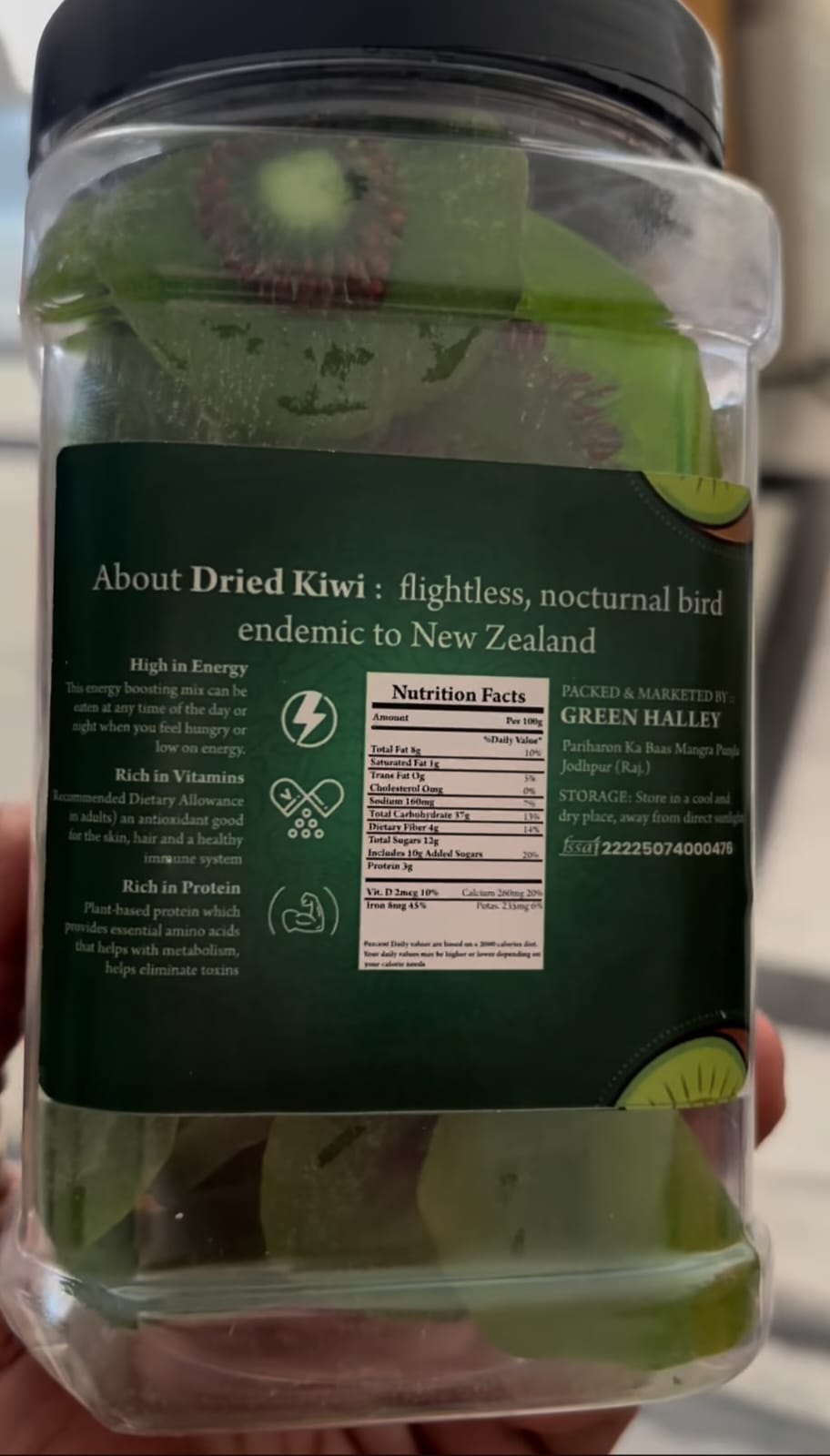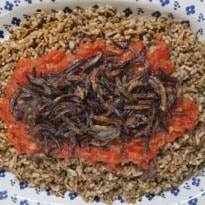Koshari
This is my home version, a cross between Lebanese mujaddarah and Egyptian koshari
Serves 6-8
For the tomato sauce
extra virgin olive oil 4 tbsp
small onion 1 , very finely chopped
garlic cloves 4, crushed
chopped canned tomatoes with their juice 2 x 400 g cans
chilli flakes ½ tsp to taste
For the koshari
extra virgin olive oil 6 tbsp
medium onions 2, thinly sliced
vermicelli 50g, broken into 2.5cm pieces
brown lentils 250g
basmati rice 275g
sea salt to taste
Put the oil and chopped onion in a saucepan and fry over a medium heat until golden. Stir in the garlic and fry for a couple more minutes then add the tomatoes and chilli. Increase the heat to medium-high and let it bubble for 20 minutes or until thickened. Use a potato masher to crush the sauce and make it smooth. Keep warm.
While the sauce is cooking, start preparing the koshari. Put the oil in a frying pan and place over a medium heat. Add the onions and fry, stirring occasionally until golden brown. Remove with a slotted spoon and spread onto paper towels to drain off the excess oil. Add the vermicelli to the oil and sauté until browned. Set aside.
Put the lentils in a saucepan with 1¼ litres of water. Bring to the boil, reduce the heat and simmer, covered, for 15-30 minutes, depending on the lentils you are using. They should be quite tender but not mushy by the time you add the rice.
Rinse the rice under cold water and add to the lentils. Simmer for another 10 minutes and stir in the vermicelli and the oil in the pan; add salt to taste. Wrap the lid of the pan with a kitchen towel, place the lid back over the pan and remove from the heat. Let it sit for 10 minutes or until the vermicelli is tender and the liquid fully absorbed. Stir in half the fried onion and reserve the other half for garnish. Use a fork to stir the rice so that you fluff it up at the same time.
Transfer the koshari to a serving dish, ladle the sauce all over and scatter the remaining caramelised onion over the sauce. Serve hot.
Fake Dolma (Dolma Kadhaba)
Kadhaba means liar in Arabic and it is a humorous way to indicate there is no meat in the stuffing.
Serves 4-6
olive oil 100ml
onions 250g, very finely chopped
chopped plum tomatoes 2 x 400g cans
sea salt
Egyptian or Calasparra rice 250g, rinsed and drained
parsley 100g, most of the stalks removed, finely chopped
mint leaves 50g, finely chopped
dill 30g, chopped medium fine
freshly ground pepper ½ tsp
allspice 1 tsp
cayenne pepper ½ tsp
juice of 3 limes juice
preserved vine leaves 1 x 450g pack
medium-large potato 1, thinly sliced
medium ripe tomatoes 2, thinly sliced
Put the oil in a saucepan and add the chopped onion. Place over a medium-high heat. Let the onion sizzle then reduce the heat to medium and sauté the onion until golden.
Add the tomatoes and salt to taste - if you are using preserved leaves go easy on the salt. Cook the tomatoes until the sauce is thick and there is no excess juice. Let cool slightly.
Put the rinsed and drained rice in a bowl. Add the herbs and tomato sauce. Add the spices and lime juice and salt to taste and mix well. Taste and adjust the seasoning if necessary.
Separate the vine leaves and stack neatly, cutting and discarding the stem and sorting them by size if you have the patience. Put the larger leaves in a colander and run cold water over them to get rid of some of the briny taste.
Use the torn leaves to line the bottom of the pan in which you will be cooking the stuffed vine leaves. Spread the potato slices over the torn leaves and cover with the tomato slices.
Take one vine leaf and lay it flat on your work surface, shiny side down with the stem end nearest to you. Place from 1-1½ teaspoons of stuffing (depending on the size of the leaf) in a thin raised line across the top of the leaf, about 1.5cm away from the tip of the stem and again the same distance short of either side - the line should be thinner than your little finger. Fold the sides over the rice, in a line that slightly tapers towards the bottom, then fold and tuck the top edges over the stuffing and roll neatly but loosely, leaving enough space for the rice to expand during cooking. Place the rolled vine leaf, with the loose end down, over the tomatoes, starting from one side of the pan. Continue filling, rolling and arranging the leaves, side by side, doing one layer at a time. Reserve one large leaf to lay over the rolled ones. If you have any leftover stuffing, put it in a small pan, add an equivalent amount of water, and cook for 20 minutes to serve on the side.
Put a little water in the bowl of stuffing and swirl it around to get the last of the juices, and pour the water over the vine leaves to about 1cm off the top. Lay the vine leaf over the rolled leaves and put an overturned heatproof plate over it, to stop the stuffed leaves from unrolling.
Cover the pan and place over a high heat. Bring to the boil, then reduce the heat to medium and boil gently for 30 minutes. It is a good idea to test one vine leaf before you take them off the heat, to make sure that both the leaf and the rice inside are done. Serve warm or at room temperature.
White Tabbule
Even though this salad is not Egyptian, it is perfect with koshari. I adapted the recipe from one I found in Ibrahim Mouzannar's Lebanese Cuisine.
Serves 4-6
pointed organic white cabbage 1, about 500g, shredded very fine
spring onions 100g, trimmed, thinly sliced
fresh mint leaves 200g, chopped medium fine
firm ripe tomatoes 400g, de-seeded, and diced into small cubes
juive of 1 lemon or to taste
extra virgin olive oil 100ml
Aleppo pepper 1 tsp
sea salt
Put the cabbage, spring onion, mint and tomatoes in a large bowl. Add the lemon juice and oil. Season with the Aleppo pepper and salt to taste. Mix well. Taste and adjust the seasoning if necessary. Serve immediately.
Egyptian Bread Pudding
Known as Umm Ali, this is the quintessential Egyptian pudding. I use toasted markouk (handkerchief bread).
Serves 4-6
markouk 250g (1¾ sheets)
mixed nuts (pistachios, hazelnuts, peanuts, cashews, almonds and walnuts) 350g
organic full-fat milk 750gJ
golden caster sugar 100gJ
orange blossom water 1 tbspJ
raisins 4 tbsp, soaked for about 1 hourJ
creme fraiche for garnish
You will also need
an oval baking dish 28cm x 24cm x 6cm
Preheat the oven to 200C/gas mark 6.
Lay one sheet of markouk over a large baking sheet and toast in the oven until golden brown. This should take about 8 minutes. Take the toasted bread out and lay the remaining markouk on the baking sheet. Toast until crisp and golden.
Break the toasted bread into medium pieces and arrange in an oval baking dish, about 28cm x 24cm x 6cm.
Spread the nuts on a large baking sheet and place in the oven. Toast for 10-12 minutes or until golden brown. Remove from the oven and cool.
Put the milk and sugar in a pan and place over a medium heat. Bring the milk to the boil, stirring every now and then. Take off the heat and add the orange blossom water.
Pour the hot milk over the bread. Drain the raisins and sprinkle all over the bread. Sprinkle the nuts all over.
Put the dish in the oven and bake for about 20 minutes until the milk is almost absorbed and the bread is a little crisp around the edges. Serve immediately with creme fraiche.
Anissa Helou is a partner in Koshari Street, 56 St Martin's Lane, London WC2N 4EA; kosharistreet.com.
In picture: Home-style koshari. Photograph: Howard Sooley for Observer Food Monthly
Her latest book is Levant: Recipes and Memories from the Middle East (HarperCollins, £20.00). To order for £16 with free UK p&p, click here












